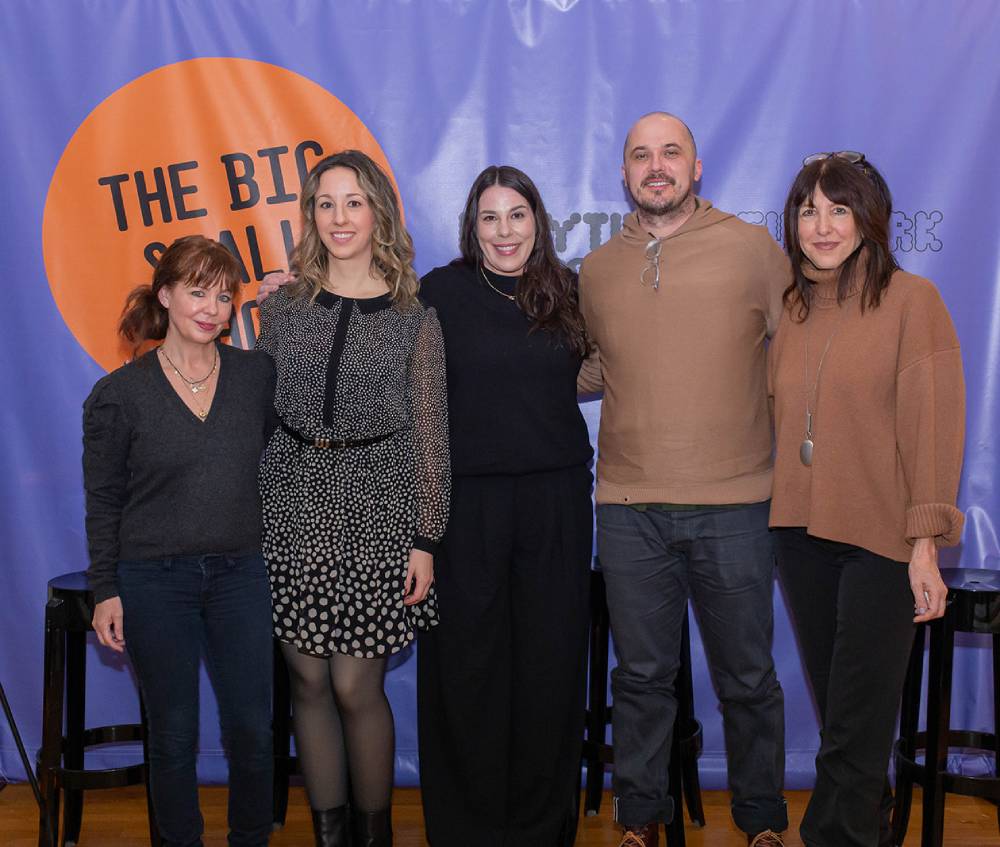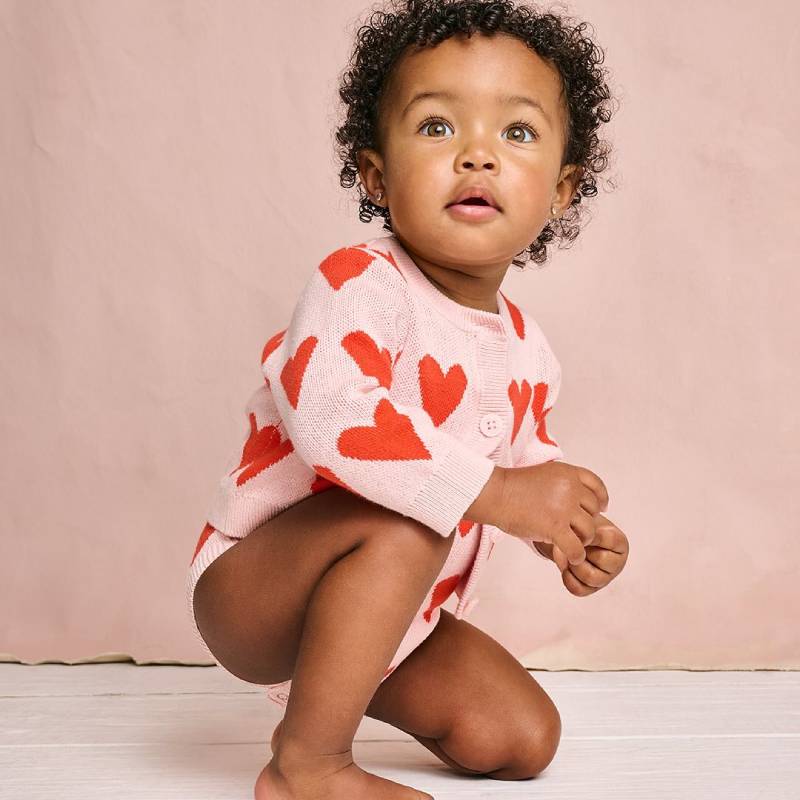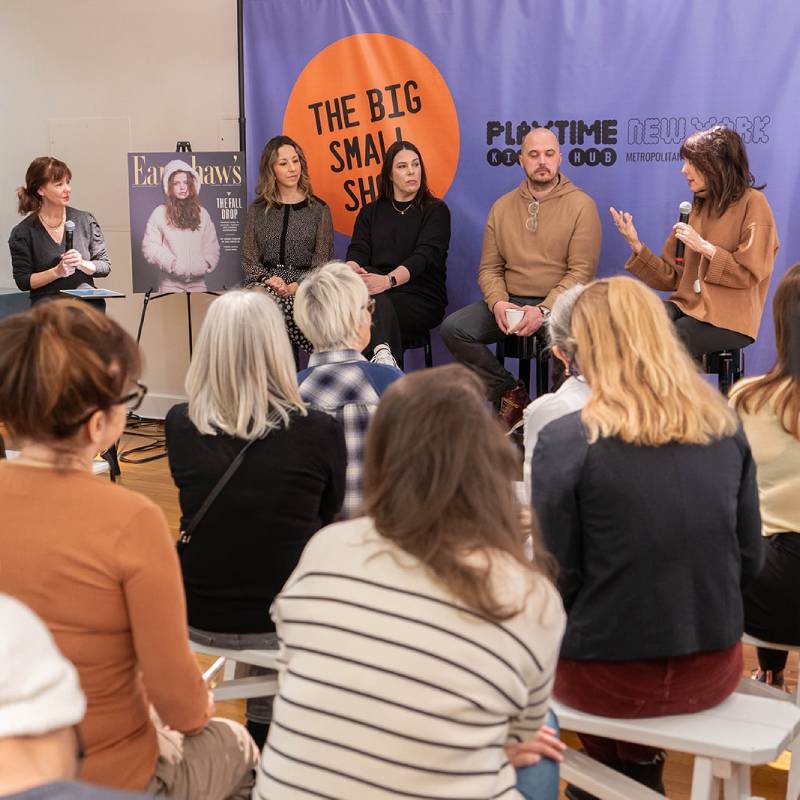Each season, we team up with our partner Earnshaw’s to host an insightful seminar at Playtime & Kid’s Hub New York. We gather a panel of experts to discuss important shifts in the children’s market and how to navigate them. Speaking to both brands and buyers, the panel each season comes from diverse backgrounds. Giving advice on this dynamic industry, the subject this season was how to build successful sustainability strategies. Jennifer Cattaui, owner of Babesta and the seminar moderator, is ready to dive deeper into this complex topic. In this article, she’ll chat with the same expert panel to bring you actionable insights.
 Successful Sustainability Strategies Panel (from left to right). Jennifer Cattaui, Owner of Babesta. Erin Rechner, Head of Kids’ Content at WGSN. Kara Carter, Chief Product Officer at Hanna Andersson. Rich Amsinger, Co-Founder of Manymoons. Randi Kronthal-Sacco, Senior Research Scholar at NYU Stern Center for Sustainable Business.
Successful Sustainability Strategies Panel (from left to right). Jennifer Cattaui, Owner of Babesta. Erin Rechner, Head of Kids’ Content at WGSN. Kara Carter, Chief Product Officer at Hanna Andersson. Rich Amsinger, Co-Founder of Manymoons. Randi Kronthal-Sacco, Senior Research Scholar at NYU Stern Center for Sustainable Business.Sustainability has never been so stylish. The fashion industry, long known for its dependance on seasonality and trends, is turning away from fast fashion and setting its sights on sustainable principles like heirloom quality and durability, hand me downs, and chemical-free processes that won’t harm the environment.
Although some of these ideas are old hat in the kid’s space — beloved brand Hanna Andersson, for instance, has been touting these things for over four decades — the world of sustainability is growing every day. There are more ways than ever for brands and retailers to manufacture and sell products that boast a net positive impact on the planet. And the good news is that consumers are in on it too. They’re demanding more from their products and the manufacturers behind them.
Erin Rechner, Head of Kids’ Content for WGSN, says she and her colleagues at the trend-forecasting firm are focusing on three main areas of sustainability. The first aspect they’re advising clients on is eliminating waste and pollution like plastic microfibers, forever chemicals, and chemical finishes. Product and material recirculation, which can be done by upcycling, recycling, and downcycling has also captured their attention. Lastly, they’re studying regenerating nature, where what’s taken from the earth is put back, and soil-friendly crops like hemp and bio-materials like mycelium and pineapple leather are favored over more consumptive options.
Rechner points to several recent innovations in the materials space that she’s excited about. One example is Pangaia’s wildflower down made from flowers grown without pesticides or artificial irrigation. This down is used as filler for their ever-popular puffers. Another example is Weganool, a plant-based wool made from a weed grown in the drylands of India. This innovative material is being used by the kidswear brand Infantium Victoria.
Even one of the most consumptive garments in fashion — denim — has gotten a sustainable makeover thanks to Italian luxury label Jacob Cohën. Jeans from the brand’s ‘Endless Luxury’ collection are 100% compostable. They achieve this by making them from 100% cotton that uses natural rubber in lieu of synthetics for stretch.
But sustainability is not without its challenges. Some of these new technologies and materials are expensive — not surprising when one is pioneering something new. Says Rechner, “The consumer mindset is very much torn and polarized. While the desire to purchase sustainable goods is growing, the evidence shows us that due to the cost of living crisis, the consumer is also looking for value — which is a paradox.”
 Manymoons’ resale shop
Manymoons’ resale shopYou may have noticed that many children’s and grown-up brands have a new tab on their websites: that of resale. Set to grow at a CAGR of 12%, and estimated to reach more than $27.5 billion by 2029, the secondhand market has officially become mainstream. This has turned sustainability into a business model. The coolest part: This sustainable business model fuels a virtuous cycle.
Rich Amsinger, Co-Founder of Manymoons, a circular retailer in children’s and adult fashion, breaks it down like this: If the garment isn’t quality, it won’t have any value on the resale market. But quality garments, even if more expensive, can live many more lives and generate even more profit, via resale. Kara Carter, Chief Product Officer at Hanna Andersson notes that they’ve even had some vintage Hanna Andersson garments posted on their pre-loved “Hanna-Me-Down” resale space that are over 20 years old.
“Synthetics do not clean well,” he notes, citing his first hand experience of taking back, cleaning, repairing, and reselling or composting. Manymoons urges customers to bring back any purchases after they’ve been outgrown for a 20% giveback credit at the store. This is a way of seeding the next shopping excursion.
Amsinger says that Manymoons started in baby clothing rental. They have since refocused their business on a mixture of online and in-store sales of new and secondhand goods. In addition, the company offers brand-partners the opportunity to have their own resale shops, powered by Manymoons’ tech and logistics on the back end. Thanks to this B2B service, partners can offer giveback and resale for their own customers without cannibalizing their new sales.
Having options to outsource the burden of logistics is welcome news for brands. As much as they may want to test the resale market, it’s like taking on a whole other job. Hanna Andersson’s Carter says that’s what kept them from dipping into resale until recently. “We knew for years that Hanna Andersson has been one of the number one resold brands on the market, but taking on the operations of a resale business was daunting. Tech made it happen for us.”
The brand uses Archive, a company that makes custom resale platforms, to fuel their peer-to-peer model for preloved garments. Carter shares that it was their goal to sync up all consumer experience around the brand. They wanted to make it efficient and reliable for consumers wanting to buy and sell used Hanna garments. Efficient it proved to be: Over 80,000 items were sold in year one.
Although the model is peer-to-peer and the brand is not financially remunerated for the sales, adding resale has raised awareness for the company’s sustainable values. It has also resulted in sales of their new clothing. “66% of resale customers that hadn’t bought from our main line in over a year went on to make a purchase,” she says.
 Hanna Andersson, 2024 Valentine’s Day collection.
Hanna Andersson, 2024 Valentine’s Day collection.In order to get a return on your sustainability investment (ROSI), the effective communication of your sustainability message is key, says Randi Kronthal-Sacco, Senior Research Scholar at NYU Stern Center for Sustainable Business. Kronthal-Sacco spearheaded a recent study with global public relations consultancy Edelman. They set out to find exactly what messages, where, and to whom, were really moving the needle for consumers when it comes to sustainability-focused communications.
“First and foremost, brands must speak to why they’re in the category. It doesn’t matter how sustainable your company is — if the product is not attractive to the consumer, they won’t purchase it,” she says. But, if the product does pass muster for desirability, sustainable claims are exceptionally appealing. They not only result in greater willingness to buy for current customers, but extend brand reach by bringing in new customers. According to the study, Kronthal-Sacco says strategic sustainable messaging raised interest from 44/100 surveyed to 77/100.
Winning messaging centers around three areas: my health, my wealth, and my personal world, affirms Kronthal-Sacco. When touting your sustainability highlight reel, she says focus on the “what’s in it for me” for the customer. Things like saving money, sourcing or producing locally, and health benefits to children and future generations performed best in the study. This bodes well for children’s clothing brands. Sustainability claims speak directly to consumers as parents who want the healthiest and safest goods for their children. “What was fantastic for us was that claims about my health, my wealth and my personal world resonated with all demographics. Younger and older, wealthy and not, right leaning and left leaning,” she says.
On the other hand, if you try to talk science with your consumer, you’ll lose them, Kronthal-Sacco notes. “They care about the effects, not the science.” Messaging around traceability, packaging, and certifications was found to be less compelling comparatively. The only exception was for Gen Z respondents, who took particular notice of these claims.
Once a company has settled on a winning sustainability message, it’s a matter of putting it out there in an influential channel. According to Kronthal-Sacco, TV ads, packaging, and in-store signage stood out as most effective. For Gen Z consumers, she says, add TikTok to the list.


For brands with a bricks and mortar retail operation, Manymoons’ Amsinger asserts the in-store sales team is also effective in sharing a brand’s sustainability message. “In store customers can touch and feel the goods, which is better than anything you could write on a website.”
Considering both the research and anecdotal evidence, brands looking to partner more deeply with the retailers carrying them may do well to provide informative signage and hangtags. Investing in educating retail associates who will pass their message to the end consumers is also important.
With so many ways to embrace sustainability, it might feel overwhelming to start. Carter offers some advice: “Know your brand and what you believe in. Know your customer and where they’re going. Then, start somewhere. If you’re a retailer, just start with a rack of resale or vintage.” Amsinger adds with regard to the product itself, brands should opt for higher margin natural fibers. These are easier to care for, longer-lasting, and more profitable on the resale market.
Rechner advises companies to keep efforts focused on their long-term strategy. “Try to make one product 100% circular, like a tee. It takes time and trial and error, but once achieved, this can be used as a base for future circular practices.”
Thank you so much to Jennifer and the expert panel! Making your own successful sustainability strategies can seem daunting. We hope these insights helped spark ideas on how to build one for your company. In our community, we know you’re already making the sustainability efforts. Now, you just have to build successful sustainability strategies that speak to your clients.
Stay tuned for next season’s seminar at Playtime & Kid’s Hub New York which will be July 28-30, 2024!